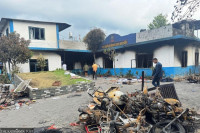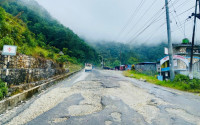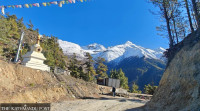Gandaki Province
Locals lament the 'emptiness' of the historical village of Gairagaun
Gairagaun is where the pioneering Dalit rights activist, Bhagat Sarbajit Bishwakarma, was born and started his activism.
Prakash Baral
The historic village of Gairagaun is a 30-minute jeep ride from the district headquarters of Baglung. The village, predominantly a Dalit settlement, carries an illustrious history. It’s the place where the free Dalit movement started; its torchbearer being Bhagat Sarbajit Biswokarma.
Today, the village, previously a part of Mulpani VDC, is a shadow of its former self; its place resigned to history. The village has 50 houses, 30 of them empty and in a state of despair. Locals lament the loss and their inability to continue the iconic status of the village.
Born in 1893, Bhagat Sarbajit Bishwokarma was the “founding leader of oppressed Dalit free movement”. Sarbajit did his Master’s in Sanskrit from Vanaras Hindu University. Inspired by the Indian Dalit Liberation Movement, Sarbajit along with other activists such as Saharsa Nath Kapali returned to Nepal. Sarbajit established Vishwa Sarvajan Sangh, the first organisation founded in Nepal with the objective to fight for Dalit rights. One time, as a 2012 study A History of Dalits in the Political Process notes, “Sarbajit Biswakarma wore Janai, a sacred thread exclusively reserved for Brahmans, in the Capital city. His action infuriated Brahmans and was assaulted and jailed. Such disobedience further encouraged other Dalits in Nepal to form similar organisations like the Vishwa Sarvajan Sangh.”
The village thus has a vaunted legacy. But, as is the case with many villages across the country, the people of Gairagaun have migrated, seeking greener pastures, either to foreign countries, to the capital, or the district headquarters.
The arable land in the village lie deserted, says a village elder Deviram BK. “This village doesn’t have youths anymore. Even those that chose to stay back do not herd cattle anymore,” the 80-year-old said. “We who are old can’t do anything.”
Many youths have settled into quiet, middle-class lives in the district headquarters, selling jewellery, their traditional occupation.
“The youths have moved out, they earn good money, and they forget the village. They never return,” Om Prakash Biswakarma, another local, said.
While the empty houses are already damaged, 15 homes of the families who chose to stay back are also in dire straits.
Ward Chairman Khaga Raj Pandey points out the need to adopt measures to return migrants back. “We should create an environment that attracts the youths,” Pandey said. “We can develop it as a tourist destination, with home stays and preserving its arts and cultural heritage.”
Pandey says that the village should tap into the contributions of Bhagat Sarbajit but the locals complain that Baglung Municipality has paid no heed to remember Bhagat Sarbajit. “Various employment and scholarship programmes could have been named after Bhagat Sarbajit,” Om Prakash said. “But the municipality has failed to address the contributions of the legendary activist.”
The very house where Sarbajit was born lies in a state of disrepair. Parashu Ram BK, secretary of the Bhagat Sarbajit Foundation, however, said the foundation has tabled plans to construct parks, develop a trekking route, and establish a museum.
“We shouldn’t let this village empty itself. We should make them come back,” Om Prakash said.




 6.84°C Kathmandu
6.84°C Kathmandu.jpg)










